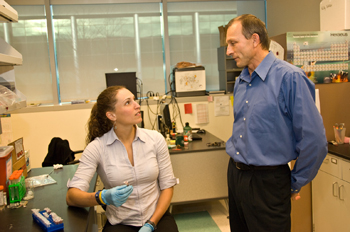- Home
- /
- News and Events
- /
- News Releases
- /
- Release
- /
UAlbany Researcher Identifies Novel Method to Improve Crime Scene Investigations
Contact(s): Catherine Herman (518) 956-8150
 |
UAlbany Associate Professor of Chemistry Igor Lednev, right, with recent UAlbany graduate Kelly Virkler. Lednev has developed innovative tools to help Crime Scene Investigators in the field. (Photo Mark Schmidt) |
ALBANY, N.Y. (July 12, 2010) -- University at Albany associate professor of chemistry Igor Lednev has developed a novel, easy-to-use approach for crime scene investigators (CSIs) to identify body fluids at crime scenes. Utilizing Raman spectroscopy, Lednev's approach will allow investigators to quickly make on-field, confirmatory identifications of body fluids. The portable spectrometers -- devices used to measure properties of light over a specific portion of the electromagnetic spectrum -- will be capable of differentiating between human and animal species, and determining the age of a biological stain.
Raman Spectroscopy Preserves Material
The process is also nondestructive. Unlike many tests currently in use by crime investigators for species identification, Raman spectroscopy doesn't destroy the samples used. The approach allows for the preservation of material for future DNA analysis. Another advantage of Lednev's approach is the fact that portable Raman instruments exist, meaning devices can be used by CSIs in the field. The end result is faster turnaround times for investigators.
Lednev's research is being funded by a $375,000 grant from the U.S. Department of Justice. His research will evaluate the feasibility of using Raman signatures for genetic profiling. The goal is to optimize the method for practical applications: putting spectrometers in the hands of CSIs with built-in software capable of differentiating between various stains or mixtures on multiple surfaces.
An Aid to Forensic Investigation
"In processing a violent crime scene, the investigators may find lots of substances, like blood," says John Hicks, director of UAlbany's Northeast Regional Forensic Institute. "Dr. Lednev's approach has the potential to greatly improve crime scene analysis by providing investigators with the tools to identify whether blood is human or from some other origin."
"The next step is to create a spectroscopic library based on donors," said Lednev. The library, which would include donors of different genders, ages and other identifiable markers, could provide investigators with the means to categorize fluids based on composition, including whether or not a sample comes from a smoker or nonsmoker.
Lednev was also recently selected to serve as an advisory member of the Research Development Testing and Evaluation Interagency Working Group (IWG) under the National Science and Technology Council (NSTC) White House Subcommittee on Forensic Science.
![]() For more news, subscribe to UAlbany's RSS headline feeds
For more news, subscribe to UAlbany's RSS headline feeds
Educationally and culturally, the University at Albany-SUNY puts "The World Within Reach" for its 18,000 students. An internationally recognized research university with 58 undergraduate majors and 128 graduate degree programs, UAlbany is a leader among all New York State colleges and universities in such diverse fields as public policy, nanotechnology and criminal justice. With a curriculum enhanced by 300 study-abroad opportunities, UAlbany launches great careers. For more information about this globally ranked University, visit www.albany.edu. For UAlbany's extensive roster of faculty experts, visit www.albany.edu/news/experts.shtml.


